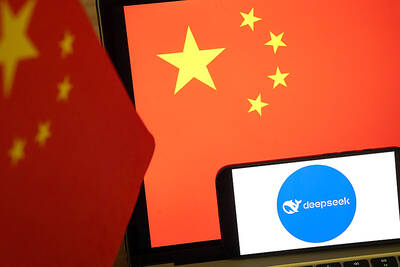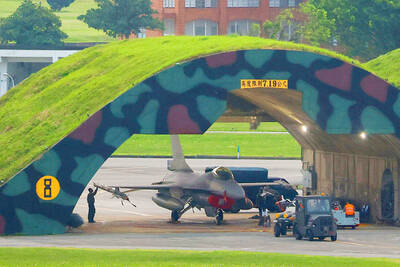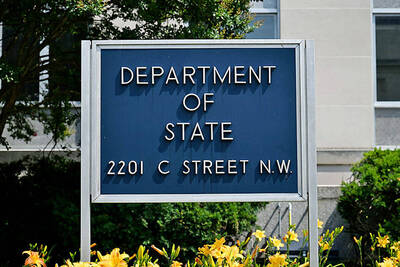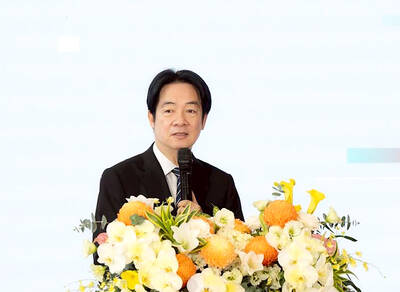China's military advantage in the Taiwan Strait continues to grow, but the Legislative Yuan's decision last year to boost defense spending will help right the balance, the Pentagon said in its annual review of China's military released in Washington on Monday.
China has been able to improve its overall military capabilities and the capabilities of its forces facing Taiwan, and continues to build up its array of short-range ballistic missiles aimed at Taiwan, the report said.
But the document disagrees sharply with President Chen Shui-bian (
US military analysts now say that China has deployed between 990 and 1,070 missiles against Taiwan, up from the 875 to 975 it estimated in last year's report. China is increasing the number of missiles by more than 100 a year, it says.
But that is still far below the more than 1,300 missiles that Chen has cited in statements over the past year.
CONCERNS
In a press briefing accompanying the release of the report, the Deputy Assistant Secretary of Defense for East Asia, David Sedney, said the missile deployment is "clearly an issue that we're very concerned about and which we have raised very strongly and consistently at high levels over the years with the Chinese."
But he had praise for Taiwan for increasing defense spending in response to the growing Chinese threat.
"We were very pleased this year that Taiwan passed ... in December a 2008 budget which increased rather substantially the amount of money and the percentage of its resources that Taiwan will be spending in its own defense. And we think that's very important," Sedney said.
PROCUREMENT
He said a near-record number of planned US arms sales to Taiwan were announced last year.
Those included 12 P-3C anti-submarine aircraft and related items worth US$1.96 billion, state-of-the-art upgrades to Taiwan's Patriot 2 anti-missile batteries worth US$939 million, and several hundred AMRAAM and Maverick missiles for use with Taiwan's F-16 fighters worth US$421 million.
The report says the legislative action, the US arms sales commitments and recent steps the Taiwan military has taken to improve its operational capabilities "have, on the whole, reinforced Taiwan's natural defensive advantages in the face of Beijing's continuing military buildup."
"We've made a number of notifications ... about the weapons systems Taiwan will be acquiring and we think those will help address the issues of the balance in the Taiwan Straits [sic]," Sedney said.
"But that certainly won't address it completely because China continues both its modernization and its deployment of forces based on Taiwan ... and we continue to not just watch it carefully but to take all appropriate measures that we have to do to be prepared for any eventuality," he said.
Asked about figures in this and last year's reports that show an actual decline in the number of Chinese ground forces deployed in the Taiwan Strait area, as well as a sharp decline in the number of bombers and fighters within range of Taiwan, Sedney downplayed the changes.
"Those are things that can change very rapidly," he said. "The Chinese have a lot of resources throughout the country which they can deploy in the Taiwan Strait area and which they practice deploying on a regular basis."
"So if you're looking at the Taiwan Strait, we wouldn't look just at any one point in time. You know, we do look at what's based there. But it's important to remember there's even a larger number of assets there," he said.
David Helvey, the director of China, Taiwan and Mongolia affairs for the US-China Economic and Security Review Commission, who also addressed the briefing, added to Sedney's comments.
"As China's military forces improve ... you see the retirement of older platforms and airframes. So in some cases, you may see a decrement in total numbers, but you have a higher percentage of much more capable platforms and systems," Helvey said.
In the report, the Pentagon also noted favorably the development of the Hsiung Feng IIE cruise missile, announced during the Han Kuang exercise in April, with a 1,000km range that enables it to reach Hong Kong and Shanghai.
RESPONSE
The Mainland Affairs Council (MAC) yesterday urged the international community to pay close attention to China's rapid military buildup, saying the Taiwan Strait has become one of the major flashpoints in the world because of Beijing's military rise.
In its official statement, MAC said the Chinese arms expansion has not only tipped the balance of power in the East Asia, but also threatened the stability in the Pacific region.
Furthermore, Taiwan has reasons to believe that Beijing still views Taiwan as its greatest enemy. Such animosity is evident in the number of missiles, increasing at a rate of 100 missiles per year, pointed at the country.
MAC called on the international community to raise suspicion about the true intention behind Beijing's military buildup.
Additional reporting by Jenny W. Hsu

MISINFORMATION: The generated content tends to adopt China’s official stance, such as ‘Taiwan is currently governed by the Chinese central government,’ the NSB said Five China-developed artificial intelligence (AI) language models exhibit cybersecurity risks and content biases, an inspection conducted by the National Security Bureau (NSB) showed. The five AI tools are: DeepSeek, Doubao (豆包), Yiyan (文心一言), Tongyi (通義千問) and Yuanbao (騰訊元寶), the bureau said, advising people to remain vigilant to protect personal data privacy and corporate business secrets. The NSB said it, in accordance with the National Intelligence Services Act (國家情報工作法), has reviewed international cybersecurity reports and intelligence, and coordinated with the Ministry of Justice Investigation Bureau and the National Police Agency’s Criminal Investigation Bureau to conduct an inspection of China-made AI language

BOOST IN CONFIDENCE: The sale sends a clear message of support for Taiwan and dispels rumors that US President Donald Trump ‘sold out’ the nation, an expert said The US government on Thursday announced a possible sale to Taiwan of fighter jet parts, which was estimated to cost about US$330 million, in a move that an expert said “sends a clear message of support for Taiwan” amid fears that Washington might be wavering in its attitude toward Taipei. It was the first announcement of an arms sale to Taiwan since US President Donald Trump returned to the White House earlier this year. The proposed package includes non-standard components, spare and repair parts, consumables and accessories, as well repair and return support for the F-16, C-130 and Indigenous Defense Fighter aircraft,

CHECKING BOUNDARIES: China wants to disrupt solidarity among democracies and test their red lines, but it is instead pushing nations to become more united, an expert said The US Department of State on Friday expressed deep concern over a Chinese public security agency’s investigation into Legislator Puma Shen (沈伯洋) for “secession.” “China’s actions threaten free speech and erode norms that have underpinned the cross-strait ‘status quo’ for decades,” a US Department of State spokesperson said. The Chongqing Municipal Public Security Bureau late last month listed Shen as “wanted” and launched an investigation into alleged “secession-related” criminal activities, including his founding of the Kuma Academy, a civil defense organization that prepares people for an invasion by China. The spokesperson said that the US was “deeply concerned” about the bureau investigating Shen

‘TROUBLEMAKER’: Most countries believe that it is China — rather than Taiwan — that is undermining regional peace and stability with its coercive tactics, the president said China should restrain itself and refrain from being a troublemaker that sabotages peace and stability in the Indo-Pacific region, President William Lai (賴清德) said yesterday. Lai made the remarks after China Coast Guard vessels sailed into disputed waters off the Senkaku Islands — known as the Diaoyutai Islands (釣魚台) in Taiwan — following a remark Japanese Prime Minister Sanae Takaichi made regarding Taiwan. Takaichi during a parliamentary session on Nov. 7 said that a “Taiwan contingency” involving a Chinese naval blockade could qualify as a “survival-threatening situation” for Japan, and trigger Tokyo’s deployment of its military for defense. Asked about the escalating tensions